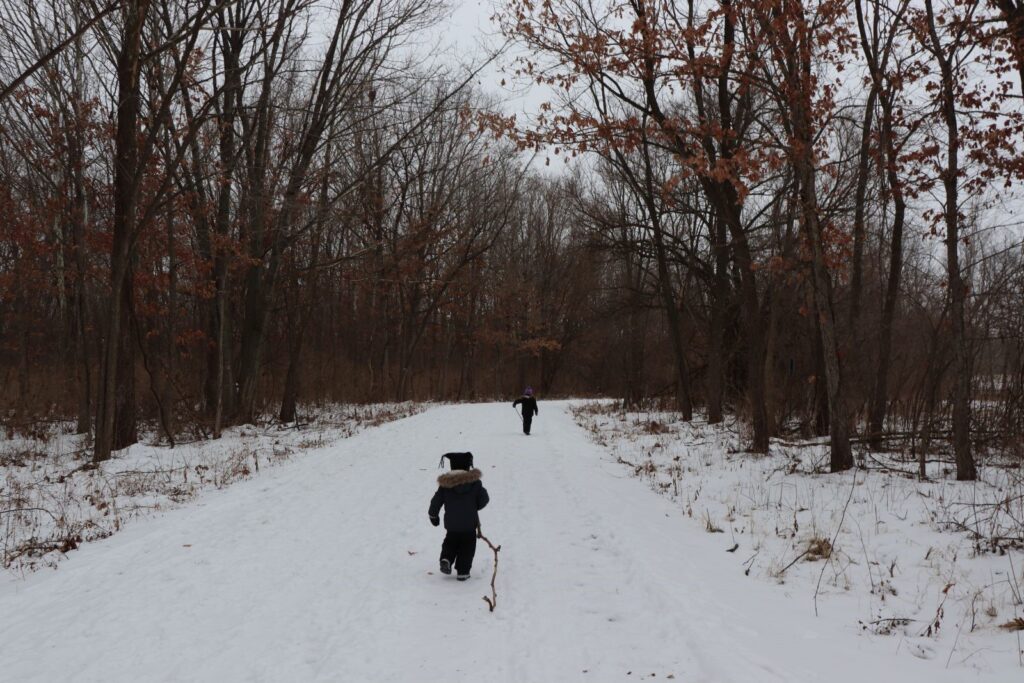By Gabriele Edwards, Urban Forestry Program Specialist, Iowa DNR
 As the temperature drops and sunlight decreases, deciduous trees shed their leaves and focus on internal storage and conserving resources. Our behavior often mirrors that of a dormant tree. It is easy to shed our active, outdoor lifestyle in favor of lounging under blankets and remaining sedentary most of the day.
As the temperature drops and sunlight decreases, deciduous trees shed their leaves and focus on internal storage and conserving resources. Our behavior often mirrors that of a dormant tree. It is easy to shed our active, outdoor lifestyle in favor of lounging under blankets and remaining sedentary most of the day.
This typically results in added “resources” (aka those pesky extra winter pounds) due to lack of activity and extra stress associated with the holidays and year-end deadlines. Unlike those powered-down trees, we need to maintain a healthy, active lifestyle throughout the colder months to keep ourselves physically, mentally and emotionally powered-up.
A walk outdoors can lift your mood. Breathing fresh, clean air and absorbing sunlight helps release serotonin. Walking in tree-covered areas is excellent for this, as light peeks through deciduous trees, while trunks, shrub branches and coniferous trees block wind to keep us warm. This brain boost releases serotonin, correlating with a drop in anxiety and depression. A walk outdoors is an opportunity to be present and mindful. It is a time to disconnect from electronics and instead connect with nature. Trees help us relax and be attentive to our surroundings, which improves our ability to focus and learn.
A walk outside, even in the cold, improves our physical health. Aerobic exercise is great for heart health by improving cholesterol, blood pressure, diabetes, obesity, vascular stiffness and inflammation, and mental stress. Winter activities such as snowshoeing, skiing, biking, sledding and walking temporarily increase heart rate, strengthening your heart and burning calories.
Trees enhance these benefits by lowering blood pressure and resting heart rate, boosting cortisol and cleaning the air you breathe. A study by U.S. Forest Service researcher Geoffrey Donovan, Ph.D., showed an increase in cardiovascular deaths in areas that lost tree canopy due to emerald ash borer controlling for other factors like diet, exercise and socioeconomics. The proximity of green space is related to good heart health, independent of the other benefits.
A trendy new activity called Forest Bathing — essentially spending mindful moments in nature — has proven some of the more intangible benefits associated with trees. Immersing oneself in nature is good for the soul, restoring and recharging us to handle life’s challenges better. While these benefits are more difficult to measure, they are nonetheless real and valuable. There is something about sitting down in nature after a hard day, reflecting on problems or simply nature itself, that calms the rough seas of your spirit. Mindfulness and awareness of your struggles and stressors seem easier to achieve when you are outdoors.
Winter brings a new sense of beauty and wonder to the natural world: sunlight through icicles, morning fog, soft bird songs, a quiet blanket of snow, the physical sensation of breathing in the cold air. Spending mindful moments outdoors in the winter can lift your spirits.
As you begin to reflect on the year ahead, perhaps commencing those new year’s resolutions, keep nature in mind for your physical, mental, and emotional well-being and fitness. Spending time outdoors reduces stress (hello, global pandemic!), improves our mood and encourages activity. End the winter dormancy cycle and break bud toward a healthier, happier and more active year ahead.
Citations:
Akers, A., Barton, J., Cossey, R., Gainsford, P., Griffin, M., Mikleright, D. (2012). Visual Color Perception in Green Exercise: Positive Effects on Mood and Perceived Exertion. Environmental Science and Technology. 46(16):8661-8666. http://www.ncbi.nlm.nih.gov/pubmed/22857379 12 September 2016.
Donovan GH, Butry DT, Michael YL, Prestemon JP, Liebhold AM, Gatziolis D, Mao MY. The relationship between trees and human health: evidence from the spread of the emerald ash borer. Am J Prev Med. 2013 Feb;44(2):139-45. doi: 10.1016/j.amepre.2012.09.066. PMID: 23332329.
Photo credit and media contact: Emma Hanigan, Urban Forestry Coordinator 515-241-1732 emma.hanigan@dnr.iowa.gov
